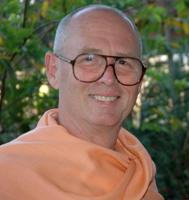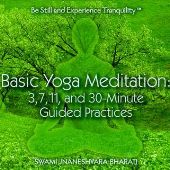| Home Site Map Tradition Inspiration What is a swami? Danda diksha |
||||||||||||
|
|
Dandi Swami
Jnaneshvara Bharati
See also the article Spontaneously practicing meditation and other yogic practices from early childhood, Swami Jnaneshvara has been a student of the Himalayan Tradition of yoga meditation since 1986 when initiated in meditation by Swami Rama (10 years to the day prior to Swami Rama leaving the body). Several months later he met Pandit Usharbudh Arya, through whom supplemental training was given from time to time during the next few years. Swami Jnaneshvara was given novice monastic initiation in 1990, was ordained as a monk (swami) of the Himalayan tradition and the order of Shankaracharya in 1993 by Swami Rama, and was given one of the highest yogic initiations of direct experience in 1996, with final teachings and instructions being imparted shortly before Swami Rama left the body in November, 1996. In 1998 and 1999 Swami Jnaneshvara received training, practices and grace from the venerated sage Naga Swami Hanuman Giri at the cave hermitages in the high Himalayas beyond Badrinath and Mana (He left the body in 2002). In 1999, initiation as Dandi Swami (a most honorific swami initiation in the Shankara tradition, in which a Danda, or staff is bestowed) was given at the bank of the Ganges in Haridwar, India by a highly revered Acharya (teacher) of Dandi Swamis, Acharya Dandi Swami Indradev Ashram. In 2000, the sage Vratti Baba of Kalimath, Himalayas passed on his initiatory transmissions at the time of his dropping the body (Vratti Baba was a long time friend and spiritual brother of Swami Rama). Swami Jnaneshvara has also been invited to be initiated as Mahamandaleshwar, said to be one of the highest leadership posts within the swami orders. The invitation has been respectfully declined so as to remain focused on the service work at hand.
With all my heart, I cannot
declare myself to be of one religion to the exclusion of the
people of others. With all my heart, I cannot exclude anyone
from the wholeness of that absolute reality called truth,
divine, god, or those other many names that state the nondual
one without a second.
If one day I say I am a Buddhist,
the next a Christian, the next a Hindu, the next a Jew, the next
a Muslim, and the next something else, has the "I" actually
changed, or only the opinions of the mind? Who am I? That cannot
be answered with a mere opinion of mind. It can only be
experienced in the stillness and silence of direct experience,
wherein these divisions evaporate. Swami Jnaneshvara
All peoples, philosophies, religions, and psychologies, while each
unique, are embraced as emerging from the same, one Absolute Reality or
Brahman, called by many other names. In 1994 Swami Rama asked Swami Jnaneshvara to remain in his Rishikesh, India ashram, saying it should be home for intensified practices and teaching. In 1995 Swami Rama said he wanted an ongoing, 12-month per year Residential Program in his ashram, directing Swami Jnaneshvara to teach in that program. The Residential Program was created over ensuing months and emphasized Swami Rama's teachings, with the program itself starting in 1996. The program was developed primarily by Swami Jnaneshvara due to the fact that the other swami in residence said he had no time for such a program, and that he would have no time in the future. After Swami Rama left the body, the program was later forced out of existence by new management who had other plans for the use of the ashram. (Some materials from the Residential Program are available in the Downloads section of the website.) Previously, Swami Jnaneshvara was at the Himalayan Institute, Honesdale, Pennsylvania, USA, and The Meditation Center, Minneapolis, Minnesota, USA, leaving them sometime after Swami Rama personally disaffiliated from them in 1993 and 1990 respectively. (Himalayan Institute)
After Swami Rama left the body in 1996, there were intense institutional politics and cleansing processes whereby many students of Swami Rama were no longer welcome at certain locations. This was mostly triggered by conflicts between two men who have falsely claimed to be the sole and authorized successor of Swami Rama, while Swami Rama himself named no successor. In light of this politics and pressure, Swami Jnaneshvara finally accepted these realities, and moved out of Swami Rama's Rishikesh ashram in 2001, returning to the US. Thereafter he was no longer affiliated with any such organization, institution, or ashram, serving instead as an independent emissary of Swami Rama and the Himalayan Tradition. In 2007 the trustees of Swami Rama's Rishikesh ashram (sadhanamandir.org) have started to reorganize the ashram programs regardless of the still present influences that brought the reduction of the teachings of Swami Rama during recent years. Swami Jnaneshvara has accepted the 2007 invitation of the trustees to be on faculty of the new programs, and has once again started teaching at the ashram, as well as at the nearby Himalayan Institute Hospital Trust (hihtindia.org). Hopefully these actions by the majority of the trustees will set the stage for creating harmony between people. There are now biannual three-week Meditation Intensive programs in the ashram (March and November).
Tribute to Swami Rama - VIDEO While Swami Rama named no single successor of the lineage, Swami Jnaneshvara is one of those whom Swami Rama empowered as a conduit of the teachings of this over 5,000 year old tradition. Inspired by the goal of providing the ancient wisdom and practices in what Swami Rama has called the "simplest manner possible," Swami Jnaneshvara provides spiritual counseling and teaches practical aspects of Meditation, Yoga, Vedanta, and internal Tantra from his home base in Fort Walton Beach, Florida, USA, while holding in heart his spiritual home of the Himalayas. As instructed by the Himalayan masters, he teaches from direct experience, teaching orally and by transmission. Our tradition is a shakti tradition and the bestowing of shakti (shaktipata) occurs along the way in the journey of sadhana, especially as it removes the final barrier leading to the realization of the Self. Although Swami Rama left no single successor and no single possessor of shakti, that shaktipata by (and of) the tradition operates through Swami Jnaneshvara and others. It is grace of formless guru that determines when and under what circumstances that gift of grace comes. Nobody is ever asked to be a follower, to change their culture, or to convert from their religion. One of the higher forms of the teaching is to encourage and train people to find the teacher within. (See also Guru and the Light within, Guru and Divine Grace, and Guru is a Stream) Most people like to
refer to Swami Jnaneshvara simply as "Swami J" or "Swamiji" as is the
traditional greeting for all swamis.
See also:
------- This site is devoted to
presenting the ancient Self-Realization path of
the Tradition of the Himalayan masters
in simple, understandable and beneficial ways, while not compromising
quality or depth. The goal of our sadhana or practices is the highest
Joy that comes from the Realization in direct experience of the
center of consciousness, the Self, the Atman or Purusha, which is
one and the same with the Absolute Reality.
This Self-Realization comes through Yoga meditation of the Yoga
Sutras, the contemplative insight of Advaita Vedanta, and the
intense devotion of Samaya Sri Vidya Tantra, the three of which
complement one another like fingers on a hand.
We employ the classical approaches of Raja, Jnana, Karma, and Bhakti
Yoga, as well as Hatha, Kriya, Kundalini, Laya, Mantra, Nada, Siddha,
and Tantra Yoga. Meditation, contemplation, mantra and prayer
finally converge into a unified force directed towards the final
stage, piercing the pearl of wisdom called bindu, leading to the
Absolute.
|
|
||||||||||
|
|
||||||||||||


